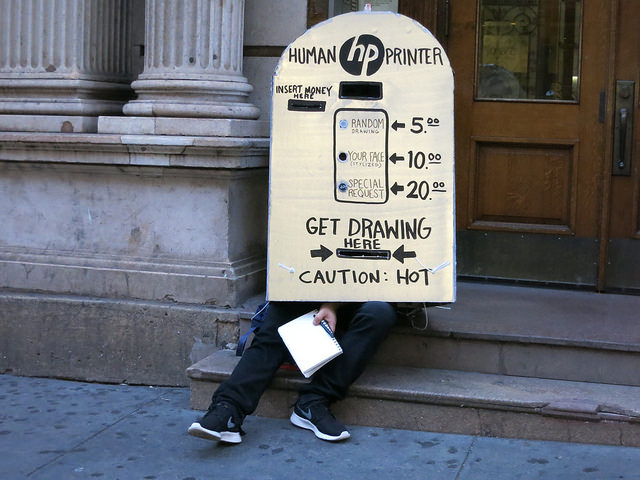Unlock the Magic in Your Story Now
Get the Free 20 questions to Ask Before Launching Your Idea workbook when you sign up for occasional updates.
Get the Free 20 questions to Ask Before Launching Your Idea workbook when you sign up for occasional updates.
Articles filed in: Storytelling
The 5 Building Blocks Of A Brand
filed in Marketing, Storytelling, Strategy
 A brand used to be an identifier, over the past seventy years it’s become so much more.
A brand used to be an identifier, over the past seventy years it’s become so much more.
Seth’s 2009 definition says it best.
“A brand is the set of expectations, memories, stories and relationships that, taken together, account for a consumer’s decision to choose one product or service over another.”
We can agree then that a brand is the meaning the customer attaches to a product or service from what she perceives. If PRODUCT + MEANING = BRAND, what creates the meaning?
5 Building blocks of a brand
1. What you (the founders and business owners) believe.
Your values, mission and vision.
2. Your voice—what you say and how you say it.
The words and tone you use to communicate your message.
3. What you do.
How you act.
4. How you make people feel.
Sometimes called user experience.
5. What you look like.
Logo, design choices, colours, seating, paper stock and on and on.
Branding is about how you facilitate the creation of meaning for your customers. The people you want to matter to need to be able to do more than recognise your brand, they need to know what it feels like to belong to it.
Image by Nina Jean.
The New Rules Of Winning
filed in Marketing, Storytelling, Strategy
 Just three months ago Volkswagen surpassed Toyota to become the world’s largest automaker.
Just three months ago Volkswagen surpassed Toyota to become the world’s largest automaker.
It’s clear that selling more cars in order to beat that competition had been the company’s goal for some time. As we’ve seen in the past week biggest doesn’t necessarily mean best.
When we use shallow metrics to judge our performance we often fail to take account of things that are harder to measure, and yet are equally (if not more) important to building a sustainable business. When we get stuck in comparison we think about making incremental improvements, tweaking what’s been done before, instead of reimagining what’s possible.
Time and again in business we’ve seen that winners don’t compete—they reframe the problem, reinvent, create and conquer new challenges and run their own purposeful race.
Winning isn’t about being the biggest or beating the competition at all costs—it’s about intentionally changing tiny edges of the world for the better.
Image by Dark Dwarf.
How To Make People Care About Your Product
filed in Marketing, Storytelling, Strategy
 The maître d’ had worked at the same restaurant for thirteen years and was ready for a change.
The maître d’ had worked at the same restaurant for thirteen years and was ready for a change.
He wanted to do work he was passionate about and decided to start a dog walking business—knowing that in order to succeed he needed to send a signal to prospective customers about how much their pets mattered.
His goal was to make people believe: ‘If this man is walking our dog, and there’s some sort of major disaster, he’s going to survive. He’s going to fish for those dogs. He’s going to build a bunker and shelter those dogs until it’s safe to bring them home.’
The marketing didn’t start with his story. It started with theirs.
The way to make people care is by first understanding what they care about.
Then you can tell the story you know they want to hear.
Image by Franklin Heijnen
The Generous Marketer
filed in Marketing, Storytelling, Strategy
 Implements long-term strategies, rather than relying on short-term tactics.
Implements long-term strategies, rather than relying on short-term tactics.
Puts the desires of the customer before the urgency of his business goals.
Knows that mattering to his customers is the key to success.
Cares about affinity, more than awareness.
Notices, before asking to be noticed.
Listens twice as much as he talks.
Does not interrupt you with a tag on your tea bag that contains a URL and reads;
“Join us on Facebook”.
We can all do better—we’ve just got to remember the value of taking the long way round.
Image by Thaths.
The Question To Ask Before Doing What You’re Planning To Do Next
filed in Storytelling, Strategy
 Before you schedule that meeting.
Before you schedule that meeting.
Before you contact that supplier.
Before you attend that conference.
Before you pay for that marketing.
Before you hire that guy.
Ask yourself this simple question:
What’s the number one outcome I want to achieve by doing this?
When you get clear (and honest with yourself) about the desired outcome, the next step you need to take becomes more obvious and more useful.
And the flip side is that it’s the best question to ask your clients and customers too.
Image by Benjamin Lehman.
A Brand Of Magic
filed in Marketing, Storytelling, Strategy
 The chairs were out of stock. A delivery was expected some time in December, it might clear customs by January. The sales assistant described the import logistics and company policy. She detailed the 55% deposit terms on all orders placed and made sure to add her name to the written quotation the customer had not requested. The customer looked unhappy.
The chairs were out of stock. A delivery was expected some time in December, it might clear customs by January. The sales assistant described the import logistics and company policy. She detailed the 55% deposit terms on all orders placed and made sure to add her name to the written quotation the customer had not requested. The customer looked unhappy.
“We need these chairs in the next couple of weeks,” he said.
“Well you’ll just have to wait,” the assistant shot back.
The customer seemed more disappointed by her attitude than he had been about the chairs.
Of course the assistant couldn’t make the chairs appear, but she had, (and missed) the opportunity to perform another brand of magic by simply acknowledging the customer’s frustration and allowing him to tell his side of the story.
Exchanging goods and services for money is the least magical part of what we do.
The miracles people want are smaller, closer and less tangible than we think.
Image by Samantha Marx.
The Business You Want
filed in Storytelling, Strategy
 If I asked you to describe the business you really want you’d probably find it hard. Here’s why.
If I asked you to describe the business you really want you’d probably find it hard. Here’s why.
We have conditioned ourselves to pay attention to popular metrics of success and we often don’t want to make the sacrifices or the compromises it takes to achieve them.
It’s akin to wanting Jennifer Aniston’s body, without wanting to be Jennifer Aniston.
Our limited worldview of success is relayed in sound bites about those who have built seven-figure businesses and companies with billion dollar valuations. We don’t hear so much about the impact they are making on their communities, one person at a time, in the lives of customers, employees and the business owners themselves. And we also don’t hear about what they gave up to get there.
To be clear I’m not knocking building a profitable, sustainable business, or striving for goals that fulfil you, what I’m saying is that you should define what success looks like for you. That takes time, reflection, personal insight and the courage to be vulnerable. You are only around bound by other people’s metrics of success when you choose to be.
The business you want doesn’t have to be defined by what’s easy to measure—things that don’t tell the whole story about what you have built, the impact you have created, the legacy you will leave or the things you had to give up along the way.
The business you want may not be a seven-figure juggernaut or the next Uber. Just because these kind of metrics are not your primary goal doesn’t mean you’re thinking small. It means you’re running your own race and you know what the finish line looks and feels like.
Image by Benjamin Lehman.
In Praise Of Intangible Value
filed in Marketing, Storytelling, Strategy
 What did they do to create value?
What did they do to create value?
Design a new portable music player or give you 1,000 songs in your pocket?
Serve coffee at $4 a cup or become ‘the third place’?
Create a platform where people can rent a room or make them feel like they belong anywhere?
Start a photo printing service or help people to make memories lasting and tangible?
Found a fitness company or create a movement?
Make a burrito or make a stand?
What will you do?
Image by Elaine
What Change Are You Making?
filed in Marketing, Storytelling, Strategy
 The sales assistant at the pop up boutique glowed. She enthusiastically pulled things one at a time from the rails to show to the customer.
The sales assistant at the pop up boutique glowed. She enthusiastically pulled things one at a time from the rails to show to the customer.
“These pants will change your life,” she said.
I thought that was a huge claim to make about what seemed like an unremarkable pair of trousers, but when the woman emerged transformed from the fitting room I began to believe it might be true.
“I love how long my legs look in these,” she said. “They are so comfortable and I can dress them up or down, they will be the only pants I pack for my next overseas trip!”
She was already standing taller and looking more confident—(it works).
The change happened in minutes right before my eyes.
When a great designer sits down to sketch he is thinking about more than how the pieces of fabric will be joined together at the seams, or how many units he needs to shift next spring. A truly great designer is thinking about the way his designs will change how a woman feels about herself when she wears them.
It’s possible to change a moment in someone’s day with a well-fitting pair of pants, a raw brownie, an excellent cup of tea or lines of code that make that moment easier, richer and better. Changed moments have a way of tumbling into one another, like dominoes that fall as if by magic in a domino run. If you’re changing a moment, you’re changing a life.
We’ve gotten used to selling ourselves, and our work short (both to the world, but most importantly to ourselves). We’ve allowed ourselves to be defined by narrow job descriptions, and what we do to be reduced to rational benefits. You are more than your job title—a barista, programmer, baker, logo designer, manufacturer or CEO, responsible for making something that works.
You are a change maker.
Often the hard part is understanding and then articulating the change you want to make.
We don’t spend enough time answering this question before we begin.
What change are you making?
Problem/Product Fit
filed in Marketing, Storytelling, Strategy
 Before you write the code, buy the domain name, design the logo, rent the office space or print the business cards ask yourself these questions.
Before you write the code, buy the domain name, design the logo, rent the office space or print the business cards ask yourself these questions.
5 questions for every entrepreneur to answer
1. Who is your customer?
2. What does she want to do, but can’t?
3. How exactly does your product or service help her?
4. Why will she choose your product or service above your competitor’s?
5. How (in words and actions) will she tell people about it?
Don’t start with your product road map—start with your customer’s story.
Image by Tina Leggio